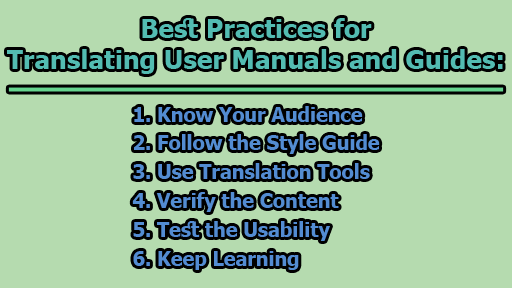Best Practices for Translating User Manuals and Guides:
Technical translation is a specialized field that demands more than just linguistic prowess; it requires domain-specific knowledge. Translators must be well-versed in the subject matter’s concepts, terminology, and conventions. User manuals and guides are common technical documents that necessitate accurate and consistent translation. In this article, we’ll delve into the best practices for translating user manuals and guides, and how to leverage domain-specific knowledge to ensure quality and clarity.
1. Know Your Audience: The first crucial step in translating user manuals and guides is understanding the intended audience. Different user groups may have varying levels of familiarity, expectations, and preferences regarding technical content. For instance, a medical device manual requires more detail and precision than a smartphone app guide. Cultural and linguistic aspects should also be considered, such as preferred units of measurement, date and time formats, symbols, and idioms. Knowing your audience allows you to tailor your translation to their needs, preventing confusion or misunderstanding.
2. Follow the Style Guide: The next step is to adhere to the style guide provided by the client or project manager. A style guide is a set of rules and guidelines that define the document’s tone, voice, format, and terminology. It ensures consistency and coherence across the text and various documents. A style guide may include information about target language variants, spelling and punctuation conventions, abbreviations and acronyms, glossaries of terms, and formatting guidelines. Following the style guide ensures that you deliver a professional and uniform translation that meets the client’s expectations.
3. Use Translation Tools: To enhance efficiency and accuracy, use translation tools that facilitate your work. Translation Memory (TM) stores previous translations, allowing for their reuse in new projects. Terminology Management (TM) organizes and maintains domain-specific terms and definitions. Computer-assisted translation (CAT) integrates TM and TM features to aid in translation. Machine Translation (MT) utilizes AI to automatically translate text between languages. Utilizing these tools can save time, reduce errors, and maintain consistency. However, always review and edit the output, as machine-generated translations may not always be entirely accurate or natural.
4. Verify the Content: After translation, verify the content’s accuracy, completeness, and correctness. Ensure that technical terms are accurately and consistently translated and that numbers, measurements, and calculations are converted correctly. Update references and ensure images, fonts, colors, and sizes align with the source document and the target audience. Verifying the content helps avoid errors, omissions, or inconsistencies that could jeopardize the document’s quality and usability.
5. Test the Usability: Testing the usability of your translation is critical. Evaluate how easily end-users can understand and follow the technical document. Read the translation aloud to assess fluency, clarity, and coherence. Seek feedback from colleagues, subject matter experts, or potential users. Perform a quality assurance (QA) check using a tool or checklist and simulate using the product or service described in the manual or guide. Identifying and addressing issues will enhance the user experience and satisfaction.
6. Keep Learning: Finally, stay updated on the latest developments, trends, and innovations in your domain of expertise. As a technical translator, actively seek new information, and gather feedback from clients, peers, and users to improve your skills. This can be achieved through reading articles, blogs, books, and journals related to your domain, attending webinars, courses, workshops, or conferences, joining online forums or groups, or consulting reliable terminology sources. Continuously learning and updating your domain-specific knowledge will keep you competitive and confident in your technical translation career.
In conclusion, translating user manuals and guides is a specialized endeavor that requires a deep understanding of both language and technical subject matter. By following these best practices, you can deliver accurate, consistent, and user-friendly translations that meet the needs of your audience and clients, ensuring the quality and clarity of technical documents.

Library Lecturer at Nurul Amin Degree College










